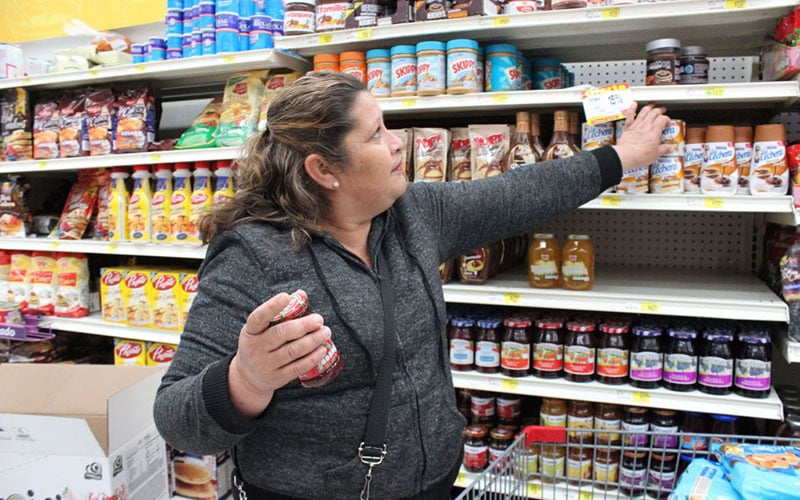
The cost of food in the Phoenix metro area rose 12.1% from June 2021 to June 2022, but that was just one of the factors that pushed the Velley near the top of metro areas for inflation, according to the Bureau of Labor Statistics. It said the biggest force behind higher prices was the soaring cost of gasoline over the year. (File photo by Molly Bilker/Cronkite News)
WASHINGTON – The Phoenix area posted one of the nation’s highest inflation rates over the past year at 12.3%, compared to a national rate of 9.1% that was itself the sharpest rise in more than 40 years.
Data released Wednesday by the Bureau of Labor Statistics said the increase in the consumer price index was largely driven by gas prices, which rose almost 60% nationally and 77% in Arizona from June 2021 to last month.
But surging prices in almost all areas, including food and shelter, also hurt consumers. The overall 12.3% increase in the Phoenix metro area was second only to the 12.4% increase posted in the Anchorage, Alaska, metro area, BLS said.
White House officials said Tuesday the June numbers do “not reflect the current reality that energy prices have now fallen significantly,” and that the situation is expected to improve soon as gas prices continue to fall. But one Arizona economist said June’s numbers are hard to ignore.
“Well, this is not good when inflation is rising this fast,” said George Hammond, director of the Economic and Business Research Center at the University of Arizona.
From cereals to poultry and used cars to utilities, prices for almost all items the federal agency keeps track of were up in the Phoenix metro area last year, soaring costs that hit low-income Arizonans hardest.
“The higher-income people have more options to change their spending patterns to reduce the impact of inflation. Lower-income households have fewer options,” Hammond said.
While gas saw the biggest increases, Hammond said food and shelter took the biggest bite out of consumers’ wallets. Rising housing costs in particular are the main culprit for high inflation rates in Arizona, he said.
The average household in Phoenix spends 34% of its budget on housing, the largest single budget expenditure, according to BLS data.
“A lot of families are struggling to pay rent,” said Beth Fiorenza, executive director of Nourish Phoenix. “Then they have all the other expenses, and God forbid, if a medical issue comes up or a car breaks down or some type of emergency, which is another expense.
“I think people are … really feeling squeezed,” she said.
That’s part of the reason Nourish Phoenix, which provides services for the area’s working poor, has seen an influx of people at its clothing and food banks. Where it would have welcomed about 100 families a day in previous months, the nonprofit said it served more than 150 families per day in June.
“They are really just climbing uphill right now and living day to day, paycheck to paycheck,” Fiorenza said.
The BLS numbers only include prices in metro areas, but inflation is also being felt in rural areas, where it “hurts far worse,” said Mignonne Hollis, executive director of Arizona Regional Economic Development Association, which specializes in rural development. Hollis said in an email that prices of goods tend to increase dramatically by the time they reach rural areas.
“Rising costs of everything from basic goods to wholesale items can be a fatal blow to rural economic development projects,” her email said.
In an attempt to slow inflation, the Federal Reserve raised interest rates in mid-June by three-quarters of a percentage point – its most aggressive hike since 1994. That came on top of increases in the 30-year mortgage rate, from just under 3% last summer to 5.3% now, Freddie Mac data shows, which has helped cool the hot housing market.
“There’s still buyers in the market, but the buyer pool has shrunk somewhat due to the interest rate,” said Eric Gibbs, the president-elect of Arizona Association of Realtors.
On one hand, that is a welcome sign for Gibbs.
“It’s been a fast-paced market for the last two plus years,” Gibbs said. “And now with a little bit of this slowdown, we can breathe a little bit. Realtors can breathe.”
But Hammond said it could have adverse effect in the long-run.
“We’re headed towards slower growth. When the economy slows down, it can tip into recession,” Hammond said. “The way to think about it is that the overall odds favor continued growth over the next year, but the risks of a downturn are elevated.”
Economists expect inflation to ease next month, as gas prices have fallen steadily in recent weeks from a highest-ever $5.38 a gallon in Arizona last month to $4.92 on average in Arizona on Wednesday, according to AAA.
The June report said the core inflation index, which excludes the volatile food and energy sectors, increased by 5.9% nationally over the year, but that it has been leveling off in recent months. Core inflation in the Phoenix area surged 10.2% last year, but Hammond said it has started to fall.
“Core inflation rate has begun to come down from its peaks. Hopefully, that will continue,” Hammond said. “If we get some good luck on gas prices, that will contribute to bringing down the all-items inflation.”
